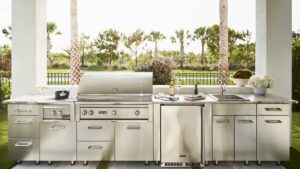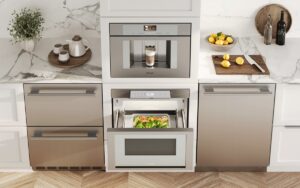A Brief Guide to Ice Maker Machines

A typical family can go through a lot of ice on a warm day and it can be hard to keep up with the demand. An ice tray can only make limited quantities of ice at a time and multiple trays can take up a lot of space in the freezer. The quality of ice is also a problem, making ice at home may help, but a lot of commercially produced ice isn’t great.
In recent years, there has been a significant uptake in the demand for ice makers to meet these needs. But, there are numerous ice makers on the market and it can be challenging to buy the right appliance to meet the needs of your family. In this article, we will take a brief look at ice makers, the various model configurations and whether they are worth the investment.
Ice Machines vs Regular Freezer Ice
The key difference between the ice that you make manually in your freezer or with a built-in kit and the ice from an ice machine is how the water is frozen. When we make regular freezer ice, we take a mold and fill each section with water by hand. Alternatively we can use a built-in water pump and freeze the ice until it’s solid and ready to use. The freezer ice may appear to be cloudy which is an indication that the ice is poor quality.
There are two main reasons for this. First, using tap water or other water that can contain suspended particles and contaminants will make the ice cloudy. Secondly, how the ice is frozen can make a huge difference in the quality of the ice. The first problem can be fixed by switching to better quality filtered water and the best ice comes from reverse osmosis (RO) filtered water.
The second problem can be solved with a dedicated ice maker machine. These appliances run a steady stream of water on the chilled surface to freeze the ice from the inside to the outside. This removes a lot of air bubbles and other impurities that contribute to cloudy ice.
You may be wondering if cloudy ice is a big deal, after ice is ice and most people wouldn’t notice the difference. But, high quality ice takes longer to melt, it tastes better and it’s an aesthetically pleasing addition to your favorite chilled beverage or a cocktail. If you really want to wow your friends and family at a party, serve drinks with great ice.
4 Ice Maker Types Explained
There are many ice makers on the market to suit a wide variety of budgets and requirements. Listing every product would be impossible and everyone has their favorite brands to consider. To simplify product research and the selection process, it can be helpful to break the ice makers down into general types or categories.
There are four main types of ice makers on the market, they are: countertop (portable), undercounter, portable, freestanding and freezer ice kits. Let’s take a look at each ice maker type in more detail to discover which one would be the right choice for your home.
1. Countertop (Portable) Ice Makers
We’ve grouped these two together for brevity, but the terms countertop and portable mean pretty much the same thing. Certain portable models may be better suited to camping trips and other outdoor activities. These ice makers tend to be the smallest appliances of this kind, they are easy to clean and simple to store.
They are a great option for people living in smaller homes or those that have limited kitchen space. A countertop ice maker can make around 10-30 lbs of ice each day depending on the specific model and size.
Pros:
- The designs are compact and they can fit any kitchen.
- Now water line installation is required to use these ice makers.
- The appliances can be stored when you don’t need them.
Cons:
- These ice makers are hard to use if the kitchen counter space is limited.
- The ice can only be produced in smaller quantities than larger appliances.
2. Undercounter Ice Makers
The undercounter ice makers are built into the kitchen cabinets and they can produce a lot of ice each day. Most models are counter-depth, they are flush with the surrounding cabinetry for sleek look. Many undercounter ice makers have an insulated storage bin that can hold 20-50 lbs of ice for instant use. For larger families with plenty of kitchen space, this is a great way to make and store a lot of ice quickly.
Pros:
- The best models are flush with existing kitchen cabinetry.
- A single undercounter ice maker can produce 20-50 lbs of ice per day.
- The insulated storage bin is an excellent addition for those with budget and space.
Cons:
- In a smaller kitchen the reduction in cabinet space can be a deal breaker.
- A water line installation will be required,
- The placement options can be limited due to the position of the water line.
3. Freestanding Ice Makers
These appliances can be a similar shape and size as the undercounter variants discussed above. They may even produce the same amount of ice each day. The main difference is that these are freestanding appliances and this means that they can be installed virtually anywhere. The only real limitation is that they will need to be connected to a water line.
Pros:
- A freestanding ice maker can produce 20-50 lbs of ice every day.
- Many of the better models include an insulated storage bin.
- These appliances are designed to be installed in a wide range of locations.
Cons:
- A freestanding design will not be a good fit for smaller kitchens with limited floor space.
- The placement options are limited by the requirement for a water line.
4. Freezer Ice Maker Kits
These are ice maker kits that are sold as add-ons for those freezers that didn’t come with an installed ice maker. A kit can be a good option for kitchens that have limited counter and cabinet space. Although external ice maker machines tend to be better they may not be the practical solution for some homes.
Pros:
- These are the most affordable way to make ice at home.
- The kits are designed to kit inside your existing freezer.
Cons:
- A freezer ice maker kit can only produce 3-5 lbs of ice a day.
- These kits are only sold for certain specific refrigerators and freezers.
- Installing a kit will reduce the available freezer storage space.
Which is the Best Ice Maker Machine?
This is a hard question to answer because the needs of the user and the restrictions of the kitchen are huge factors. If you’re the type of person that likes to host huge parties serving cocktails and other chilled beverages you’re probably in the market for an undercounter or freestanding ice maker. If you have more modest entertaining requirements and a small kitchen you may find that those larger models are overkill. For a single person or a smaller family, a countertop ice maker should suffice. When you understand your needs it’s much easier to choose the right appliance.
6 Key Ice Maker Features
Like any appliance, ice makers vary in price and quality and for the most part you tend to get what you’re paying for. But, there are six key features that you need and these are often found on budget ice makers too:
- Ice Production: If you have a family that consumes large volumes of ice each day you need to choose an ice maker that has a sufficiently high production rate to meet the demand.
- Installation: If you have a kitchen that has free cabinet space to install an undercounter ice maker this may be your best option. If the space is limited you may find a separate area when you could install a freestanding unit or choose a countertop model.
- Storage Capacity: To fill a cooler you will need an ice maker with a large storage capacity and/or an insulated storage bin.
- Water Filters: A water filter that can remove the sediment that makes ice cloudy is a great way to upgrade your homemade ice. Some models have built-in filters and others may have addons sold separately. When the water filter is changed regularly and cleaned the ice will be clear, crisp and last longer.
- Drainage: The freestanding and undercounter ice makers will need a drainage line to remove the melted ice.
- Design: Modern ice makers are available in a wide range of finishes to match the other appliances in your kitchen.
Are Ice Makers Worth the Investment?
This is a question that every buyer will need to answer themselves. An ice maker is a great fit for families that tend to consume large volumes of ice on a regular basis. A typical freezer ice tray can only produce 6-18 ice cubes at the same time. More ice can be made with multiple trays, but there are limits and this may be an inefficient solution. Ice makers can produce a wide range of ice shapes, they may have faster ice options and clear ice technology to improve the ice quality.
If you’re considering a new ice maker, you can explore the options with our online collection or speak to one of our home appliance experts for personalized service.
- The Ultimate Outdoor Grill Guide for 2025: Built-In vs. Freestanding
- Smart Bathroom Faucets & Fixtures in 2025: Blending Technology with Luxury Design
- Built-In Coffee Machines: Are They Worth It for Your Kitchen in 2025?
- How to Choose the Right Dishwasher for Your Home: Noise, Capacity, and Features Explained
- Top 5 Kitchen Appliance Colors and Finishes for 2025 (And How to Match Your Style)
- Why a Countertop Ice Maker is a Must-Have for Summer Kitchen Upgrades in Southern California
- How to Remove Scratches from Stainless Steel Luxury Appliances
- When Is the Best Time to Buy Appliances? Your 2025 Buying Guide
- The Ultimate Guide to Outdoor Beer Dispensers: Elevate Your Backyard Entertaining in 2025
- Choosing the Perfect Bathtub: Freestanding vs. Built-In Styles for a Luxury Bathroom






